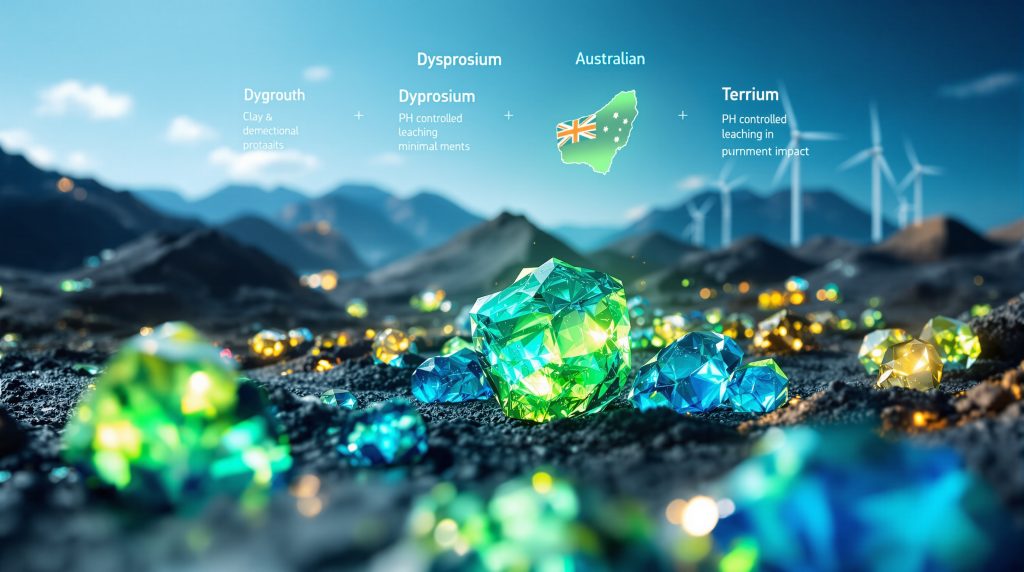Understanding ABx Group's Deep Leads Project: A Breakthrough in Rare Earth Extraction
Tasmania hosts one of Australia's most promising rare earth discoveries, with ABx Group's Deep Leads project emerging as a standout development in the critical minerals strategy. Located 45km west of Launceston in northern Tasmania, this ionic adsorption clay (IAC) deposit represents a significant advancement in Australia's rare earth element capabilities.
Strategic Resource Significance
Deep Leads boasts exceptional concentrations of heavy rare earth elements, particularly dysprosium and terbium. With 89 million tonnes of rare earth-bearing clay material averaging 844 parts per million (ppm) total rare earth oxides, the deposit stands as a substantial resource in the global rare earth landscape.
What truly distinguishes Deep Leads is its remarkable 36ppm combined dysprosium and terbium content, confirmed as the highest concentration in any Australian ionic adsorption clay deposit and among the most significant globally. This exceptional grade places the project in a unique position within Australia's critical minerals reserve.
The strategic location in northern Tasmania provides logistical advantages with proximity to existing infrastructure, facilitating more efficient development and eventual production.
Recent Testing Validates Deep Leads' Extraction Potential
Australia's Nuclear Science and Technology Organisation (ANSTO) recently conducted diagnostic leach tests on samples from Deep Leads, delivering results that confirm or exceed ABx Group's earlier in-house findings.
Impressive Recovery Rates
The independent testing by ANSTO revealed extraction rates exceeding 70% for the high-value heavy rare earth elements dysprosium and terbium. These elements are particularly valuable in global supply chains due to their critical applications and limited availability outside China.
Notably, the testing demonstrated effective leaching at pH levels above 4, which represents a significant technical advantage. This higher pH processing approach reduces impurity extraction, lowers reagent consumption, and creates a more environmentally benign extraction process compared to conventional methods.
Mark Cooksey, Managing Director and CEO of ABx Group, emphasized the strategic importance of these results, noting that "achieving such high extractions of dysprosium and terbium is particularly encouraging" given their status as "the most strategically valuable rare earths."
The Critical Value of Dysprosium and Terbium
Heavy rare earth elements like dysprosium and terbium command premium prices in global markets due to their essential role in advanced technologies and critical minerals energy transition.
Essential Applications in Modern Technology
These elements are fundamental components in manufacturing high-performance permanent magnets, which are critical for electric vehicle motors, wind turbine generators, and various defense applications. The unique properties of dysprosium and terbium allow for magnets that maintain performance at high temperatures, a crucial characteristic for many advanced applications.
According to industry analysts, dysprosium prices have historically reached $400-1,000/kg during supply constraints, reflecting their critical importance in global technology supply chains.
Supply Chain Vulnerabilities
Global production of heavy rare earths remains heavily concentrated in China, which controls approximately 85% of worldwide production. This concentration creates significant supply chain vulnerabilities for Western economies and manufacturers.
Recent geopolitical tensions and potential export restrictions have heightened concerns about secure access to these materials, driving increased interest in non-Chinese sources like Deep Leads. The U.S. Department of Defense and other Western government agencies have identified heavy rare earths as materials of critical strategic importance, further enhancing the value proposition of projects like Deep Leads.
Advantages of Ionic Adsorption Clay Deposits
The unique characteristics of ionic adsorption clay deposits offer several significant advantages over traditional hard rock rare earth mining operations.
Processing Simplicity and Efficiency
Unlike conventional rare earth deposits that require intensive crushing, grinding, and complex chemical processing, IAC deposits like Deep Leads enable more straightforward extraction methods. The rare earth elements in these deposits are weakly bound to clay particles, allowing for simpler leaching processes.
This geological characteristic translates to practical benefits: lower energy consumption, reduced processing complexity, and potentially faster time-to-market compared to hard rock mining projects. The absence of radioactive elements like thorium and uranium, which often complicate conventional rare earth processing, represents another substantial advantage of IAC deposits.
Environmental Considerations
The environmental footprint of IAC projects tends to be significantly smaller than traditional rare earth mining. These deposits typically require:
- Minimal excavation due to their shallow nature
- No crushing or grinding facilities
- Lower water consumption
- Reduced waste rock generation
- Simpler rehabilitation processes
The higher pH leaching process confirmed by the ANSTO testing further enhances the environmental profile of the Deep Leads project, potentially positioning it as one of the more environmentally responsible rare earth developments globally.
ABx Group's Innovative Extraction Approach
The company has developed a specialized extraction methodology tailored specifically to the unique characteristics of Tasmanian IAC deposits.
Technical Process Evolution
ABx is currently advancing its process development through systematic testing. Following the successful diagnostic leach tests, the company is preparing to conduct slurry tests on its material with higher solids loading to more closely simulate commercial conditions. This represents a critical step in scaling the technology toward commercial application.
The extraction approach focuses on optimizing several key parameters:
- Maintaining pH levels above 4 to minimize impurity extraction
- Reducing reagent consumption to improve economics
- Selectively recovering valuable heavy rare earths
- Simplifying waste management processes
This methodical approach to process development aligns with industry best practices for bringing new extraction technologies to commercial readiness.
Development Pathway for Deep Leads
ABx Group is advancing rapidly toward commercial development with several key milestones on the horizon.
Near-Term Objectives
The company is on track to produce a mixed rare earth carbonate (MREC) sample through ANSTO in Q4 2025. This represents a crucial step in the development pathway, as MREC is the standard tradable product in rare earth supply chains.
Following the MREC sample production, ABx will commence issuing samples to prospective customers, initiating the critical commercial engagement process. The company aims to position itself as the first MREC producer from an ionic adsorption clay resource in Australia, establishing a strategic foothold in critical mineral supply chains.
Further milestones likely to follow include pilot plant design and construction, feasibility studies, and environmental permitting processes, though specific timelines for these stages have not been publicly disclosed.
Competitive Positioning in the Global Rare Earth Landscape
Deep Leads offers several distinctive advantages compared to competing rare earth projects globally.
Comparative Technical Advantages
The project's 36ppm dysprosium and terbium grade represents a significant competitive advantage. Most other rare earth projects contain substantially lower concentrations of these high-value heavy rare earths, often in the 10-30ppm range.
When comparing development pathways, IAC projects like Deep Leads typically offer:
- Lower capital intensity than hard rock projects
- Faster time-to-production
- Reduced technical complexity
- Lower environmental impact
- Minimal radioactivity concerns
These advantages create a compelling case for Deep Leads as a strategic supplier of critical heavy rare earths.
Market Positioning Strategy
ABx appears to be positioning Deep Leads as a premium supplier focused specifically on the most critical and valuable rare earth elements. This targeted approach differs from many rare earth projects that focus on higher volume but lower value light rare earths.
The potential to establish a non-Chinese supply source for heavy rare earths could command price premiums from manufacturers seeking supply chain diversification. Western governments have increasingly supported domestic critical mineral development, potentially creating policy tailwinds for projects like Deep Leads.
Economic Considerations and Market Dynamics
The exceptional extraction results for dysprosium and terbium strengthen the economic case for developing Deep Leads as a strategic rare earth source.
Value Drivers
Several factors contribute to the project's potential economic value:
- Premium pricing for dysprosium and terbium ($400-1,000/kg historically)
- Growing demand from electric vehicle and renewable energy sectors
- Supply constraints from traditional sources
- Western government support for critical mineral development
- Potential for strategic offtake agreements with magnet manufacturers
The simplified processing approach demonstrated in the recent testing could translate to lower capital and operating costs, further enhancing the project's economic profile.
Market Growth Trajectory
The market for heavy rare earths is closely tied to the growth of electric vehicles and renewable energy. Industry forecasts project significant growth in both sectors over the coming decades, creating substantial demand growth for materials like dysprosium and terbium.
While precise production costs haven't been publicly disclosed, the project's processing advantages suggest potential for competitive cost positioning compared to other non-Chinese sources.
Environmental Responsibility and Sustainability
Though specific environmental initiatives for Deep Leads haven't been detailed, the project's technical characteristics suggest several inherent environmental advantages.
Inherent Environmental Benefits
The higher pH leaching process validated by ANSTO testing represents a more environmentally benign approach compared to conventional rare earth processing, which often relies on more aggressive chemical treatments.
The absence of radioactive elements commonly associated with conventional rare earth mining eliminates one of the industry's most challenging environmental considerations.
The project's location in Tasmania, a jurisdiction with well-established environmental regulations, provides a framework for responsible development practices. Furthermore, the project is well-positioned to demonstrate significant decarbonisation benefits compared to traditional rare earth mining operations.
FAQ: Deep Leads Rare Earth Project
What makes Deep Leads different from other rare earth developments?
Deep Leads contains exceptional concentrations of high-value heavy rare earths (dysprosium and terbium) in an ionic adsorption clay deposit, allowing for simpler, more environmentally friendly extraction compared to traditional hard rock mining.
Why are dysprosium and terbium considered strategic materials?
These elements are essential for manufacturing high-performance permanent magnets used in electric vehicles, wind turbines, and defense applications. Supply is currently dominated by China, making alternative sources strategically important for Western economies.
How does ionic clay extraction compare to conventional rare earth mining?
Ionic clay extraction typically involves simpler processing with lower energy requirements, reduced chemical consumption, and minimal radioactive waste issues compared to conventional hard rock mining and processing.
What timeline is ABx Group targeting for commercial production?
The company is advancing rapidly toward commercial development, with mixed rare earth carbonate samples expected in Q4 2025, followed by customer engagement and project scaling.
How might geopolitical factors impact the project's importance?
Growing tensions and export restrictions affecting rare earth supply chains increase the strategic value of non-Chinese sources like Deep Leads, potentially attracting government support and premium pricing.
Conclusion: A Strategic Asset in the Critical Minerals Landscape
ABx Group's Deep Leads project represents a significant development in Australia's critical minerals sector. With its exceptional dysprosium and terbium grades, favorable extraction characteristics, and strategic position in global supply chains, the project offers compelling potential as a future source of these strategically important materials.
As electric vehicle adoption accelerates and renewable energy deployment continues to expand globally, securing responsible sources of critical minerals like heavy rare earths becomes increasingly important. Projects like Deep Leads that offer both technical and environmental advantages may play a crucial role in diversifying global supply chains for these essential materials.
The recent positive testing results from ANSTO mark an important milestone in the project's development journey, validating its technical approach and moving it closer to commercial reality. For investors, industry participants, and policy makers focused on mining sustainability transformation, Deep Leads represents a development worth watching closely as it progresses toward potential production.
Want to Invest in the Next Rare Earth Discovery?
Explore how ASX-listed rare earth discoveries like ABx Group's Deep Leads can transform investment portfolios with Discovery Alert's proprietary Discovery IQ model, providing real-time notifications on significant mineral announcements across the ASX. Discover why major mineral discoveries can lead to substantial returns by visiting the Discovery Alert dedicated discoveries page.




